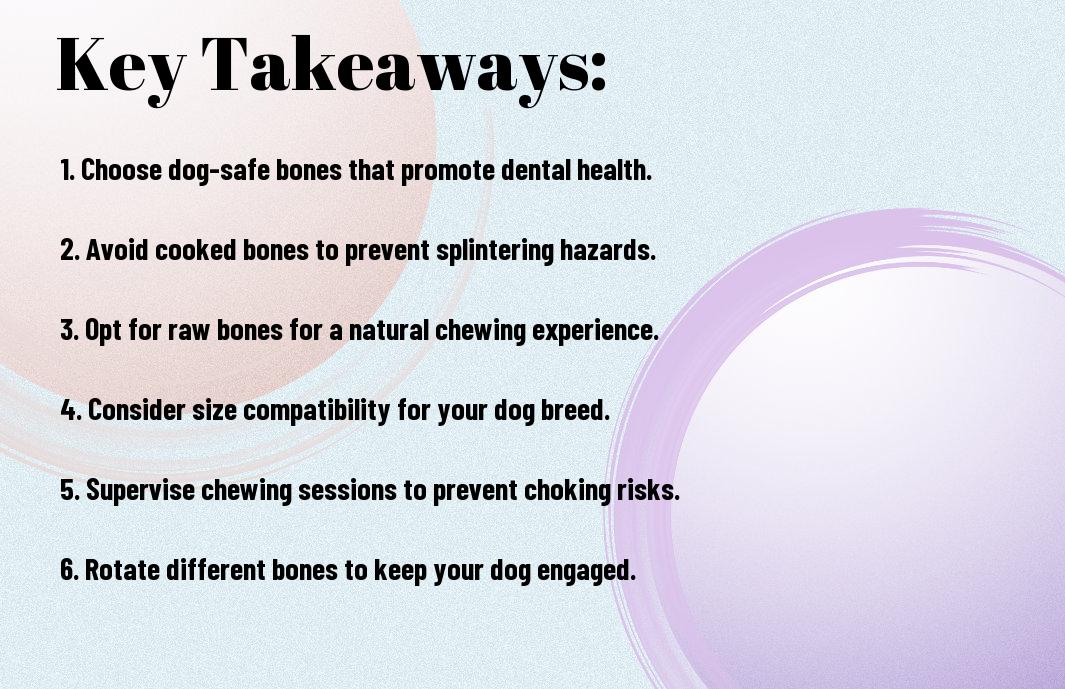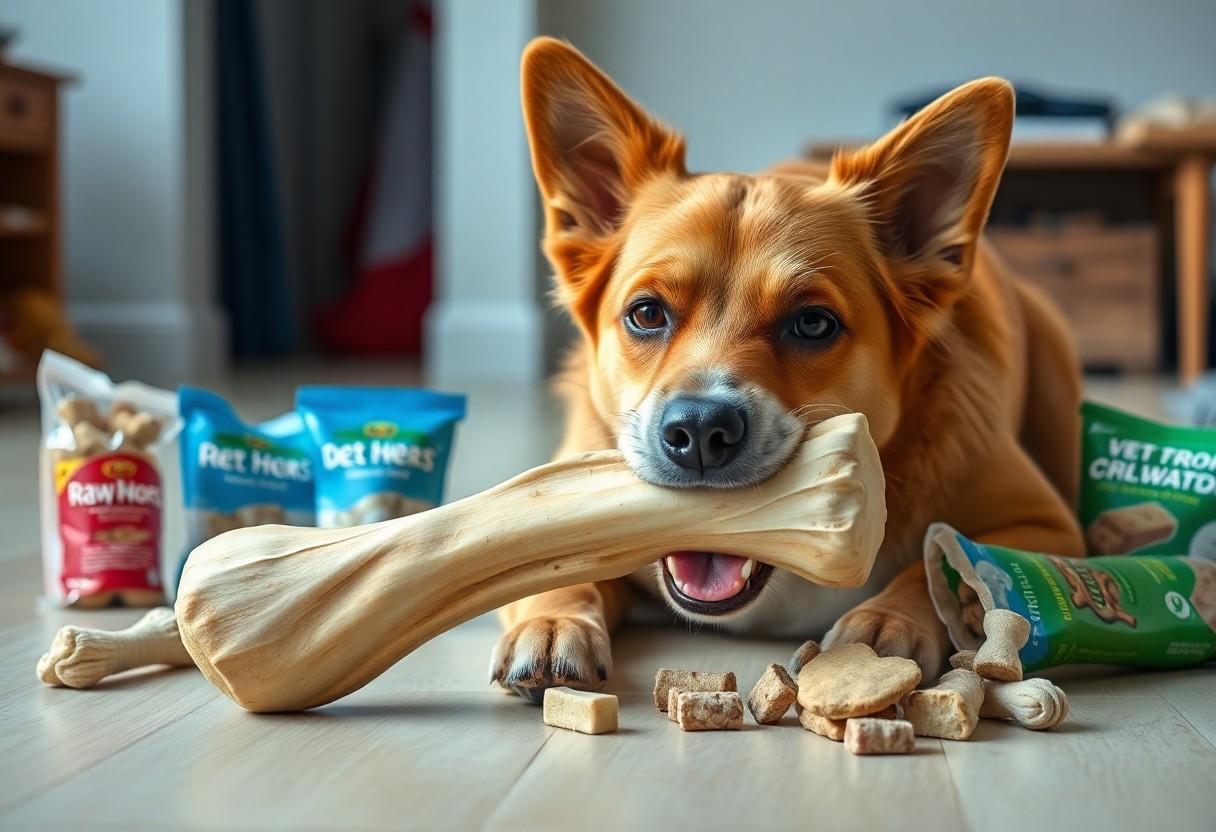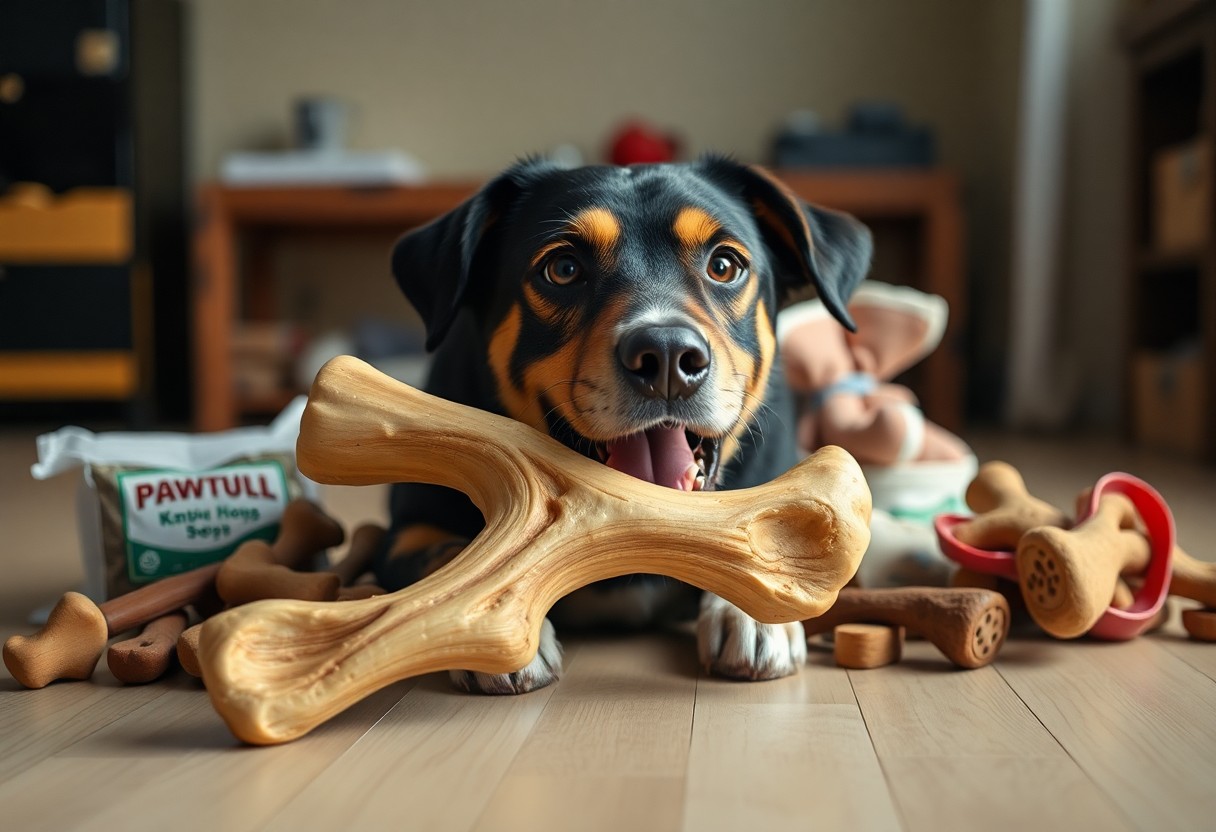Chewing the right bone is crucial for keeping your dog entertained and satisfied. Choosing the right bone can promote oral health, prevent destructive behavior, and provide a wholesome source of enjoyment. However, not all bones are created equal; some can pose serious health risks such as choking or intestinal blockage. In this informative post, you’ll discover vet-approved picks that ensure your furry friend has safe, nutritious, and satisfying chewing options. Let’s probe the best choices for your dog’s next chewing adventure!
Key Takeaways:
- Choose bones that are appropriately sized for your dog to prevent choking hazards and ensure safe chewing.
- Opt for durable, natural options such as raw bones or marrow bones that are less likely to splinter and cause digestive issues.
- Always supervise your dog while they chew to monitor for any potential problems and consult with your veterinarian on the best choices for your pet’s dental health and dietary needs.

Importance of Chewing for Dogs
The act of chewing is instinctive for dogs and serves several functions that contribute to their overall well-being. Not only does it help with dental health by reducing plaque and tartar, but it also provides mental stimulation and can alleviate boredom and anxiety. By providing your dog with appropriate chewing options, you are fulfilling their natural instincts while promoting a happier and healthier lifestyle.
Benefits of Chewing
The benefits of chewing extend beyond mere enjoyment for your dog. Chewing helps strengthen their jaw muscles, aids in cleaning their teeth, and can even keep them occupied, reducing the likelihood of destructive behaviors. Additionally, when you choose the right chew options, you can provide necessary nutrients and support healthy teeth and gums, making it an integral part of your dog’s daily routine.
Risks of Chewing the Wrong Bones
An important consideration when selecting bones for your dog is the potential risks involved. While chewing is beneficial, not all bones are safe and some can lead to serious health issues.
Even seemingly harmless bones can pose risks. For example, cooked bones can splinter and cause internal injuries or obstruction in your dog’s digestive system. Additionally, bones that are too small might pose a choking hazard, while those that are too hard may lead to broken teeth. To safeguard your dog’s health, it’s vital to choose the right type of bone that effectively combines enjoyment with safety. Always consult a veterinarian for recommendations tailored to your dog’s size and chewing habits.

Types of Bones Suitable for Dogs
While selecting the right bone for your dog, you should consider various types that cater to their chewing needs. Here are some safe options:
| Type of Bone | Characteristics |
|---|---|
| Raw Bones | Nutritious, promotes dental health. |
| Cooked Bones | Usually unsafe, can splinter easily. |
| Synthetic Chews | Durable, often flavored, safe choice. |
| Marrow Bones | Delicious, high in fat for energy. |
| Chew Toys | Safe alternative, comes in various materials. |
Recognizing the best bone options can enhance your dog’s chewing experience and overall health.
Raw Bones
Above all, raw bones are a natural and nutritious choice for your dog. They are rich in necessary nutrients and can help promote healthy teeth and gums by reducing tartar buildup. Just ensure that the bones are large enough to prevent choking and supervise your dog during chewing sessions.
Cooked Bones
Types of bones that have been cooked are usually unsafe for dogs due to their propensity to splinter, posing a risk for internal injuries. Cooked bones lose their structure and can break apart easily, which may lead to choking or damage to the digestive tract.
Another significant concern with cooked bones is the potential for blockages or lacerations in your dog’s gastrointestinal system. Always opt for raw options instead and avoid cooked bones entirely to keep your dog safe.
Synthetic Chews
Between your various options, synthetic chews are an excellent alternative to natural bones. They are designed to withstand rigorous chewing and provide a long-lasting satisfying experience without the dangers posed by real bones. Additionally, many synthetic options feature appealing flavors that entice dogs to engage with them.
Chews made from synthetic materials come in different shapes and sizes, ensuring there’s something for every dog. While they provide many benefits, it’s necessary to choose ones made from non-toxic materials, as some low-quality products may pose health risks. Always prioritize your dog’s safety when exploring chew options.

Vet-Approved Bone Options
After reviewing numerous options, veterinarians often recommend specific bones that are safe and beneficial for your dog. These options typically include raw bones, which can provide imperative nutrients and dental benefits. However, it is imperative to choose the right size and type to prevent potential hazards and ensure your furry friend enjoys chewing without any risks involved.
Recommendations from Veterinarians
About various types of bones, veterinarians frequently suggest raw, meaty bones. These are less prone to splintering and can support your dog’s dental health while providing mental stimulation. Always consult with your vet to determine the best options tailored to your dog’s specific needs and chewing habits.
Popular Brands and Products
At your local pet store or online, you’ll find a variety of reputable brands that offer safe chewing options for your dog. Some popular choices include Nylabone, Benebone, and PetStages, each providing a range of flavors and textures designed to satisfy your dog’s chewing instincts.
In fact, brands like Nylabone and Benebone focus on durability and safety, ensuring that your pet can enjoy their chewing experience without being at risk of ingesting harmful splinters. Look for chew bones made from high-quality materials and check for safety certifications when selecting a product. Choose the right size to match your dog’s breed and chewing habits, as this can significantly impact their enjoyment and safety when chewing on bones.
Factors to Consider When Choosing a Bone
Not all bones are created equal, and several factors can affect your dog’s chewing experience. It’s vital to consider the following:
- Size of the bone relative to your dog
- Durability based on your dog’s chewing habits
- Ingredient composition for any potential allergens
- Intended purpose, whether for dental health or pure enjoyment
Knowing the right factors will help you select a bone that suits your dog’s needs while ensuring their safety.
Dog Size and Breed
By understanding your dog’s size and breed, you can choose a bone that is safe and enjoyable for them. Larger breeds may require tougher bones, while smaller dogs might struggle with oversized pieces. Tailoring the bone size to your dog’s breed ensures they can chew without choking hazards.
Allergies and Dietary Restrictions
Consider your dog’s allergies and dietary restrictions when selecting a bone. Many dogs have sensitivities to certain proteins or ingredients found in commercial bones. Opt for bones that are made from single-source proteins and are free of common allergens.
Even the healthiest dogs can develop food allergies, making it important to monitor their reactions. Some of the most dangerous allergens may include certain meats, grains, or artificial additives. Choosing bones made from natural, limited ingredients can often lead to a more positive chewing experience. Always consult your veterinarian if you notice any signs of allergic reactions in your pet, such as itching or gastrointestinal issues.
Safety Tips for Dog Chewing
Keep your dog safe while they enjoy their chewing experience by following these important tips:
- Choose a durable bone appropriate for your dog’s size.
- Always supervise your dog to prevent choking hazards.
- Avoid bones that are too hard, like antlers or bones from large animals.
- Check for any sharp edges or splinters before giving a bone.
- Immediately remove any pieces that break off during chewing.
Recognizing the signs of trouble early can help ensure your dog has a safe and enjoyable chewing experience.
Supervision and Monitoring
The best way to protect your dog during chewing sessions is to keep a close eye on them at all times. Supervision allows you to quickly step in if your dog starts to choke or chew off dangerous pieces. Make sure to limit chewing time to avoid overzealous habits and keep a relaxing environment that encourages good chewing behavior. This practice not only prevents potential accidents but also strengthens your bond with your furry friend.
Recognizing Dangerous Signs
Above all, it’s important to watch for any dangerous signs while your dog is chewing. If your dog begins to cough, gag, or shows signs of distress, take the bone away immediately. Additionally, if you notice excessive drooling, blood in saliva, or if your dog seems lethargic or unwilling to eat, these could indicate serious issues related to chewing.
Another important aspect of recognizing these dangerous signs is being aware of your dog’s behavior after chewing sessions. If they exhibit persistent signs of discomfort or refusal to chew afterward, it could mean that the bone is causing them pain. Additionally, watch for any gastrointestinal distress such as vomiting or diarrhea. These signs are warning indicators that the bone may not be safe for your dog. Always consult your veterinarian if you suspect your dog may be injured or unwell.
Alternative Chew Options
For many dogs, traditional bones might not be the best choice. Exploring alternative chew options can help satisfy your dog’s natural chewing instincts while promoting dental health. Look for safe and durable chew products designed to withstand rigorous gnawing, as well as considering items that keep your dog mentally and physically engaged.
Chew Toys
Between the variety of chew toys available, you can easily find ones that match your dog’s size and strength. Look for toys made from durable materials like rubber or nylon, which can withstand heavy chewing. These toys can provide both entertainment and dental benefits, helping to clean your dog’s teeth while enticing them to chew.
Edible Chews
An excellent alternative to traditional bones is edible chews. These treats not only satisfy your dog’s chewing needs but can also provide some nutritional benefits. Many options available are designed specifically for dental health, helping to reduce plaque and tartar buildup.
But not all edible chews are created equal. It’s important to choose options that are safe and suitable for your dog’s size. Some edible chews, like bully sticks or dental chews, can be great for cleaning teeth but can also pose choking hazards or cause digestive issues if swallowed whole. Ensure you monitor your dog while they enjoy these treats, allowing them to enjoy a safe and tasty experience.
FAQ
Q: What types of bones are generally safe for dogs to chew on?
A: Safe options for dog chewing include raw bones, such as beef or lamb bones, which are softer and less likely to splinter. Antler bones and nylon bones are also popular choices among dog owners. Always avoid cooked bones as they can splinter and pose serious risks to your dog’s health.
Q: How should I choose the appropriate size bone for my dog?
A: Selecting the right size bone is important for your dog’s safety and enjoyment. As a general guideline, choose a bone that is larger than your dog’s mouth to prevent choking. For small to medium-sized dogs, bones that are about the size of their muzzle work well. Larger breeds typically require bigger bones to accommodate their stronger jaws.
Q: Are there specific brands or products that are highly recommended for dog chewing?
A: Yes, several vet-approved brands are known for their quality and safety. Some notable options include Benebone, Nylabone, and the PetSafe Busy Buddy line. Always look for products that are specifically designed for chewing and have good reviews from both vets and pet owners.
Q: How often should I give my dog a bone to chew on?
A: Frequency varies depending on your dog’s size, chewing habits, and the type of bone. It is generally safe to provide a bone one to two times a week as a special treat. Always supervise your dog while they are chewing to prevent any accidents or overzealous chewing that could break teeth.
Q: What should I do if my dog shows signs of distress while chewing a bone?
A: If your dog exhibits any signs of distress, such as excessive drooling, choking, or difficulty swallowing, it is important to intervene immediately. Take the bone away and assess your dog’s condition. If symptoms persist or if you notice any injuries to the mouth or gums, consult your veterinarian for guidance.
